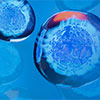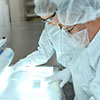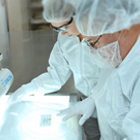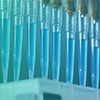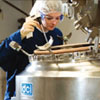acids+and+salts+high+purity
Numéro de catalogue:
(BOSSBS-11793R-A555)
Fournisseur:
Bioss
Description:
Sulfonylureas are a class of drugs commonly used in the management of noninsulin-dependent diabetes mellitus. ENSA/ARPP-19, also known as ARPP-19e, is a 121 amino acid protein that localizes to the cytoplasm and belongs to the endosulfine family. ENSA/ARPP-19 is an endogenous regulator of the β-cell K(ATP) channels and reduces K(ATP) channel currents by inhibiting sulfonylurea from binding to the receptor thereby stimulating insulin secretion by pancreatic β cells. It is suggested that ENSA/ARPP-19 expression is decreased in brains of both Alzheimer's disease (AD) and Down's syndrome patients. Widely expressed with high levels in skeletal muscle and brain and lower levels in pancreas, ENSA/ARPP-19 is phosphorylated by PKA and exists as eight alternatively spliced isoforms. ENSA/ARPP-19 is encoded by a gene located on human chromosome 1q21.3.
UOM:
1 * 100 µl
Numéro de catalogue:
(BOSSBS-15140R-A555)
Fournisseur:
Bioss
Description:
C22orf43 (chromosome 22 open reading frame 43), also known as MGC33025 or MGC75009, is a 229 amino acid protein encoded by a gene located on human chromosome 22, which contains over 500 genes and about 49 million bases. As the second smallest human chromosome, chomosome 22 contains a wide variety of genes with numerous functions. Phelan-McDermid syndrome, Neurofibromatosis type 2 and autism are associated with chromosome 22. A schizophrenia susceptibility locus has been identified on chromosome 22 and studies show that 22q11 deletion symptoms include a high incidence of schizophrenia. Translocations between chromosomes 9 and 22 may lead to the formation of the Philadelphia Chromosome and the subsequent production of the novel fusion protein, BCR-Abl, a potent cell proliferation activator found in several types of leukemia.
UOM:
1 * 100 µl
Numéro de catalogue:
(BOSSBS-8079R-FITC)
Fournisseur:
Bioss
Description:
Chromosome 22 contains over 500 genes and about 49 million bases. Being the second smallest human chromosome, 22 contains a surprising variety of interesting genes. Phelan-McDermid syndrome, Neurofibromatosis type 2 and autism are associated with chromosome 22. A schizophrenia susceptibility locus has been identified on chromosome 22 and studies show that 22q11 deletion symptoms include a high incidence of schizophrenia. Translocations between chromosomes 9 and 22 may lead to the formation of the Philadelphia Chromosome and the subsequent production of the novel fusion protein, BCR-Abl, a potent cell proliferation activator found in several types of leukemia. CCDC134 (coiled-coil domain containing 134), also known as MGC21013 or FLJ22349, is a 229 amino acid protein encoded by a gene mapping to human chromosome 22.
UOM:
1 * 100 µl
Numéro de catalogue:
(BOSSBS-12943R-CY7)
Fournisseur:
Bioss
Description:
Casein kinase I (also designated CKI) and casein kinase II (CKII) compose a family of serine/threonine protein kinases which are present in all eukaryotes examined to date. Casein kinase I family members, which include casein kinase I Alpha, I Gamma, I Delta and I Epsilon, have been implicated in the control of cytoplasmic and nuclear processes, including DNA replication and repair, membrane trafficking, circadian rhythm, cell cycle progression, chromosome segregation, apoptosis and cellular differentiation. Casein kinase I isoform alpha-like (CSNK1A1L) is a 337 amino acid protein that shares a high degree of sequence similarity with the alpha isoform of casein kinase 1. CSNK1A1L resides in the cytoplasm and participates in the Wnt signaling pathway. By utilizing ATP within its protein kinase domain, CSNK1A1L phosphorylates a large number of proteins.
UOM:
1 * 100 µl
Numéro de catalogue:
(BOSSBS-7781R-CY5.5)
Fournisseur:
Bioss
Description:
Required for S phase entry of the cell cycle.The eukaryotic cell division cycle consists of a number of gene-controlled sequences that involve cyclin dependent kinases (Cdks) and cell division control (Cdc) proteins. Cdc123 (Cell division cycle protein 123), also known as D123, is a 336 amino acid cytoplasmic protein that is involved in cell cycle control. Widely expressed with high expression in thymus, spleen, ovary, testis, small intestine and leukocytes, Cdc123 functions to destabilize Chfr (checkpoint with forkhead and ring finger domain) proteins which, when accumulated, block the G to S phase transition. Cdc123 prevents the Chfr proteins from collecting in the cell, thereby allowing the cell to enter the S phase. Due to its role in cell cycle control, Cdc123 is thought to be a basal marker for luminal breast cancers.
UOM:
1 * 100 µl
Numéro de catalogue:
(BOSSBS-7781R-CY3)
Fournisseur:
Bioss
Description:
Required for S phase entry of the cell cycle.The eukaryotic cell division cycle consists of a number of gene-controlled sequences that involve cyclin dependent kinases (Cdks) and cell division control (Cdc) proteins. Cdc123 (Cell division cycle protein 123), also known as D123, is a 336 amino acid cytoplasmic protein that is involved in cell cycle control. Widely expressed with high expression in thymus, spleen, ovary, testis, small intestine and leukocytes, Cdc123 functions to destabilize Chfr (checkpoint with forkhead and ring finger domain) proteins which, when accumulated, block the G to S phase transition. Cdc123 prevents the Chfr proteins from collecting in the cell, thereby allowing the cell to enter the S phase. Due to its role in cell cycle control, Cdc123 is thought to be a basal marker for luminal breast cancers.
UOM:
1 * 100 µl
Fournisseur:
MP Biomedicals
Description:
Ammonium Molybdate Tetrahydrate is an analgesic.
Numéro de catalogue:
(BOSSBS-12124R-CY7)
Fournisseur:
Bioss
Description:
The GAT1 gene family includes sodium- and chloride-dependent plasma membrane transporters for neurotransmitters, metabolites and osmolites, which couple substrate flux to transmembrane electrochemical gradients. PROT (Sodium-dependent proline transporter), also known as Solute carrier family 6 member 7, is a 636 amino acid multi-pass membrane protein that is a GAT1 family member specifically expressed in regions of the brain. PROT terminates the action of proline by its high affinity sodium/chloride-dependent reuptake into pre-synaptic terminals. Enriched in glutamatergic synaptic terminals, it is likely that PROT plays an important role in excitatory events of neurotransmission. PROT-mediated proline uptake is inhibited by compounds such as benztropine, LP-403812 and Des-Tyr-Leu-enkephalin (GGFL). These inhibitors of proline uptake may lead to the development of therapeutic agents for certain neurologic disorders.
UOM:
1 * 100 µl
Numéro de catalogue:
(BOSSBS-9727R-CY7)
Fournisseur:
Bioss
Description:
BAR proteins are characterized by a common N-terminal BAR (bin, amphiphysin and Rvs161/167) domain and are recognized as adaptor proteins that are involved in many cellular processes. BIN1 and BIN2 are BAR proteins that share 61% sequence similarity. BIN1 (Bridging integrator 1) is a ubiquitously expressed regulatory protein for synaptic vesicle endocytosis. BIN1 also interacts with the transcription factors c-Myc and MyoD, potentially functioning as a tumor suppressor. BIN2, also known as Breast cancer-associated protein 1, is a 565 amino acid protein that interacts with BIN1. In contrast to BIN1, BIN2 lacks tumor suppressor features as well as a c-Myc interacting region. BIN2 shows preferred expression in tissues of hematopoietic origin, with high levels found in spleen, thymus, colon, placenta, lymphoid and granulocytic cells. There are two isoforms of BIN2 that are produced as a result of alternative splicing events.
UOM:
1 * 100 µl
Numéro de catalogue:
(BOSSBS-11884R)
Fournisseur:
Bioss
Description:
The Drosophila atonal gene produces a protein with basic helix loop helix (bHLH) domains that plays an essential role in the development of the Drosophila nervous system. Mammalian atonal homolog 2 (MATH-2) is a helix-loop-helix (HLH) transcription factor that is structurally homologous to the product of Drosophila atonal gene. MATH-2 is a 337 amino acid protein with an atonal-related basic HLH domain. In mice, expression of MATH-2 takes place by embryonic day 11.5 and initially localizes to the wall of brain vesicles and in the spinal cord. It is expressed in the cortical plate and the mantle layer in the developing central nervous system, and is limited to the nervous system in adults. Adult mouse cerebrums produce a high level of MATH-2 RNA with lower levels in other neuronal tissues. Research studies suggest that MATH-2 may function as a trans-acting factor involved in the development and maintenance of the mammalian nervous system.
UOM:
1 * 100 µl
Numéro de catalogue:
(BOSSBS-3800R-FITC)
Fournisseur:
Bioss
Description:
Immunoglobulins belong to a group of related glyco proteins which make up 20% of serum proteins. Antigens and immunoglobulins react to confer immunity to individuals. Immunoglobulins have similar structures of two identical heavy chains and two identical light chains. Both the heavy chains and the light chains are divided into constant and variable regions. The constant regions have the same amino acid sequences between all the immunoglobulin classes. The variable regions have approximately 110 amino acids with high sequence variability. The amino acid sequence of the heavy chain determines the class of an immunoglobulin. The five types of immunoglobulin heavy chains are known as: IgG, IgA, IgM, IgD, and IgE. IgG is divided into four subclasses, and IgA is divided into two subclasses. In serum IgA and IgG are monomers with a single 4 polypeptide unit; while, IgM is a pen tamer. IgA may also form polymers. Kappa light chain antibody can be used for the identification of leukemias, plasmacytomas and certain non Hodgkin's lymphomas. Kappa light chain contains one immunoglobulin like domain. The EU sequence has the INV allotypic marker, Ala 45 and Val 83. The ROY sequence has the INV allotypic marker, Ala 45 and Leu 83.
UOM:
1 * 100 µl
Numéro de catalogue:
(BOSSBS-3800R-A488)
Fournisseur:
Bioss
Description:
Immunoglobulins belong to a group of related glyco proteins which make up 20% of serum proteins. Antigens and immunoglobulins react to confer immunity to individuals. Immunoglobulins have similar structures of two identical heavy chains and two identical light chains. Both the heavy chains and the light chains are divided into constant and variable regions. The constant regions have the same amino acid sequences between all the immunoglobulin classes. The variable regions have approximately 110 amino acids with high sequence variability. The amino acid sequence of the heavy chain determines the class of an immunoglobulin. The five types of immunoglobulin heavy chains are known as: IgG, IgA, IgM, IgD, and IgE. IgG is divided into four subclasses, and IgA is divided into two subclasses. In serum IgA and IgG are monomers with a single 4 polypeptide unit; while, IgM is a pen tamer. IgA may also form polymers. Kappa light chain antibody can be used for the identification of leukemias, plasmacytomas and certain non Hodgkin's lymphomas. Kappa light chain contains one immunoglobulin like domain. The EU sequence has the INV allotypic marker, Ala 45 and Val 83. The ROY sequence has the INV allotypic marker, Ala 45 and Leu 83.
UOM:
1 * 100 µl
Numéro de catalogue:
(BOSSBS-3800R-A350)
Fournisseur:
Bioss
Description:
Immunoglobulins belong to a group of related glyco proteins which make up 20% of serum proteins. Antigens and immunoglobulins react to confer immunity to individuals. Immunoglobulins have similar structures of two identical heavy chains and two identical light chains. Both the heavy chains and the light chains are divided into constant and variable regions. The constant regions have the same amino acid sequences between all the immunoglobulin classes. The variable regions have approximately 110 amino acids with high sequence variability. The amino acid sequence of the heavy chain determines the class of an immunoglobulin. The five types of immunoglobulin heavy chains are known as: IgG, IgA, IgM, IgD, and IgE. IgG is divided into four subclasses, and IgA is divided into two subclasses. In serum IgA and IgG are monomers with a single 4 polypeptide unit; while, IgM is a pen tamer. IgA may also form polymers. Kappa light chain antibody can be used for the identification of leukemias, plasmacytomas and certain non Hodgkin's lymphomas. Kappa light chain contains one immunoglobulin like domain. The EU sequence has the INV allotypic marker, Ala 45 and Val 83. The ROY sequence has the INV allotypic marker, Ala 45 and Leu 83.
UOM:
1 * 100 µl
Fournisseur:
Honeywell Chemicals
Description:
Ammonium heptamolybdate tétrahydraté 81.0-83.0% (base MoO₃) ACS, Fluka™
Fournisseur:
Thermo Scientific
Description:
Sodium perchlorate monohydraté ≥85.0-90.0% ACS
Fournisseur:
OMEGA BIO-TEK
Description:
The E.Z.N.A.® Universal Pathogen Kit allows for the rapid and reliable isolation of high quality host genomic DNA, gram positive and negative bacterial DNA, fungal spore DNA and viral DNA and viral RNA from tissue, urine, serum and fecal samples.
Appel de prix
Le stock de cet article est limité mais peut être disponible dans un entrepôt proche de vous. Merci de vous assurer que vous êtes connecté sur le site afin que le stock disponible soit affiché. Si l'
Le stock de cet article est limité mais peut être disponible dans un entrepôt proche de vous. Merci de vous assurer que vous êtes connecté sur le site afin que le stock disponible soit affiché. Si l'
Ces articles ne peuvent être ajoutés au Panier. Veuillez contacter votre service client ou envoyer un e-mail à vwr.be@vwr.com
Une documentation supplémentaire peut être nécessaire pour l'achat de cet article. Un représentant de VWR vous contactera si nécessaire.
Ce produit a été bloqué par votre organisation. Contacter votre service d'achat pour plus d'informations.
Le produit original n'est plus disponible. Le remplacement représenté est disponible
Les produits marqués de ce symbole ne seront bientôt plus disponibles - vente jusqu'à épuisement de stock. Des alternatives peuvent être disponibles en recherchant le code article VWR indiqué ci-dessus. Si vous avez besoin d'une assistance supplémentaire, veuillez contacter notre Service Clientèle au 016 385 011.
|
|||||||||




